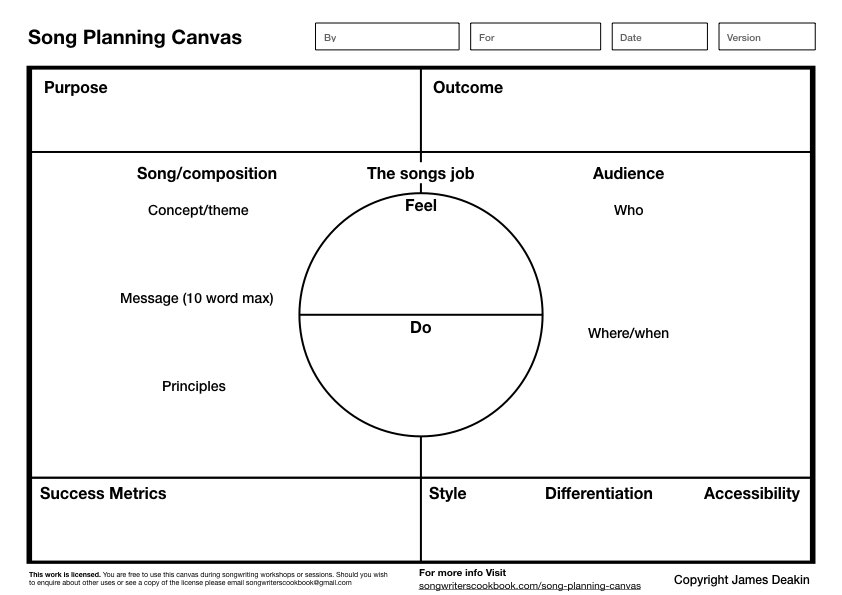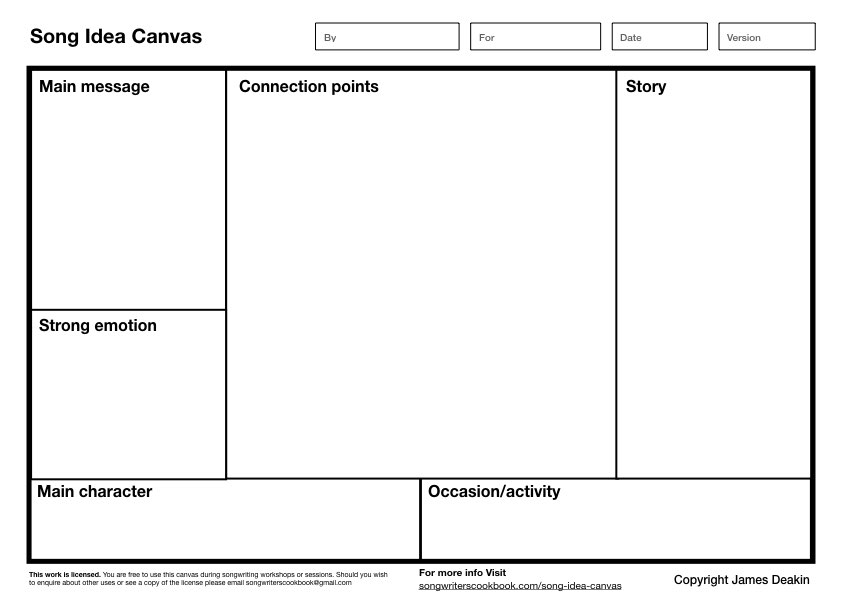How to find song ideas
You don’t need to suffer from writers block. There are lots of great ways to find something to write about.
The challenge
It’s sometimes tough to find a song idea. You’re not alone if you are struggling. We hear the following from would be songwriters all the time:
- I don’t know what to write about
- I’ve got writers block
- I don’t feel confident writing lyrics, I feel I will be judged
The solution
Anytime you find yourself stuck for a song idea use some of the following proven methods.
Develop the habit of spotting ideas
- Know that there’s no reason to have writers block. Using the following approach (or similar) has worked for lots of writers
- Stop being too hard on yourself. We all have a brutal inner critic that stops us pursuing anything that looks unlikely to succeed. Turn the inner critic off till you need them
- Focus on your audience rather than on ego centric writing. This helps turn off the inner critic.
- Know what you are looking for. If you don’t know what you are looking for you won’t find it easily
- Keep a song idea book, catch those ideas as they pop up
- Use any of the following recipes to generate lots of song ideas
Recognise good song ideas
If you know what makes a great song idea it’s easier to spot potential. This is hard because great song ideas seem to hide their potential.
Abstract concepts like love and freedom are really hard to write about. It’s often better to focus on tangible experiences. The things many people do in day to day life are ideal. The best songs about big ideas often come from describing simple everyday things. There are no rules in songwriting and you can find exceptions to every case but if your song idea has the following it’s more likely to work.
- A clear main message (that you can express in less than 10 words)
- Powerful emotional (potential)
- Story (potential)
- Connection points (situations and feelings the audience knows)
1. A clear main message
If your song has a strong, clear message it will be easier for you audience to identify with and for you to write the song in the first place. Lets look at some existing songs as examples.
Giant by Rag n bone man and Calvin Harris: The main message is “With your support I am strong”.
Respect by Aretha Franklin: says “I’m an equal in this partnership”
2. Powerful emotional potential
Giant makes me feel powerful, it’s an uplifting feeling. Together we are great and can achieve anything we need to.
Respect also conveys a feeling of personal power. We all feel empowered as Aretha demands what she’s entitled to.
3. Story potential
Stories in songs are usually very simple. Both of these songs have implied characters and we can read into them filling the void with our own experiences. They have just enough story to keep us interested.
Who is the other person in giant who holds the singer up? Who was their unrequited love? We don’t know but we are intrigued.
We don’t know the couple in Respect but we can imagine…
4. Connection points
The audience can connect with these songs. We can all relate. They are singing about situations we can recognise and feelings we know. They are about home, pills and money. These are topics that turn up in everyday life for many people.
Find ideas with free writing
This is a great technique to unpack things that may be in your head. A great deal goes on below the surface and free writing can unlock some of our best ideas. Read how here
Test ideas with sensory writing
This is one of the most powerful methods in the songwriters use. It generates language that prompts feelings in the audience. It can transport you to a place and time or convey emotion. It allows us show the audience not tell.
It’s also a great way to find out if an idea has legs. If you’re drawing a blank when sensory writing you might want to try another topic.
Give it a try with our sensory writing recipe.
Strategise with the Song planning Canvas
Use this canvas to intentionally target an audience with your song. Here’s how to use it:
1. Download the canvas
Clicking this link to download a PDF of the canvas (interactive version coming soon)
2. Print it out
A3 or A4, or US letter paper should work. I find larger versions helpful however.
3. Fill in the purpose box
What is your song for? Is it a pop song, a piece of music in a video game? Part of a film score.
4. Fill in the outcome box
Imagine the song is a great success. What would that success look like? Millions of streams on spotify? National press taking about it? Be as specific as you can about what you would like to achieve.
5. Think about the audience
Fill in the right hand side of the canvas. Describe your audience. Experiment with different ways to fill this out, this could mean:
- Describing their personal style and interests. E.g. A person who feels like and outsider. That likes to dress differently to show they aren’t like everyone else.
- It might mean describing a situation they are in: A tired worker, heading home on the long train ride, feeling drained from another day dealing with difficult people and problems
- Anyone who wants to escape their in laws during the holidays
Think about where they might be and how that place looks and feels
6. Find a theme
This could be as simple as “falling in love” it might be an activity like “working nine to five”. Write that theme down on the left hand side.
7. Find the the key message of your song
Try to summarise the main message in less than ten words. This is not the plot or action of the song. Main messages are often very simple statements. They are direct and to the point. Write it into the spot on the left. If you need more help on this read our find the key message of your song recipe.
8. Define the job your song will do for your audience
This is essential, if your song is delivering the right emotion at the right time for the right people you are bound to be onto a winner. Write down what you want the audience to feel and what you would like them to do as a result of hearing your song.
9. Make some decisions
Now you know what job you are trying to do and for whom you can start to make better decisions about your song. What style should it be in? Are there any guiding principles you will use as you make it? How will you know when you have succeeded?
10. For extra credit
Analyse a few of your favourite songs using the canvas:
- Who is their audience?
- What job does the song do for their audience?
- What musical and lyrical choices are helping them achieve their aim?
Expand your ideas using the Song Idea Canvas
Use the song idea canvas to flesh out audience centred song ideas.
1. Download the canvas
Download a PDF of the canvas by clicking this link (interactive version coming soon)
2. Print it out
A3 or A4, or US letter paper should work. I find larger versions helpful however.
3. Write in your main message and strong emotion
4. Find connection points
Familiar experiences help transport your audience into the song. This is a good time to use sensory writing. Dive into the topic and try to describe authentic sensations connected to your songs theme. Write the best of them into the connection points box.
5. Story and characters
What is happening in your song and who is this song happening to? Describe this but remember to keep it simple. If you read lyrics from some of your favourite songs you will find that the stories are often very simple indeed.
Spark new ideas with different approaches
Babble technique
Words carry meaning but they are also sounds. Sometimes an idea for a song emerges from babbling along to an existing piece of music or a riff you have created. Try it out.
Write a sequel
Find a song that already exists and extend its story. You can choose the refute the message of the original or take it further. This is a great fun way to create songs. Method coming soon
Practise active listening
Listen to conversations, discreetly. Use this method to find inspiration in things people actually say. Method coming soon
Turn any experience into a song
Any experience no matter how mundane can become material to work with. Nine to five by Dolly Parton, working at the carwash anything can spark ideas. Method coming soon
Force connections
Smashing together unrelated ideas and topics can yield remarkable results. Use this method to create colourful metaphors. Method coming soon
Find ideas in other media
Book titles, newspaper articles, movie scenes and even race horse names can all provide the spark you need to find great ideas. Method coming soon
Use locations to spark ideas
Visit locations and use techniques to find ideas. Method coming soon
Cut-ups and serendipity
David Bowie, Kurt Cobain, Thom Yorke and possibly John Lennon have used this technique for finding great ideas and even lyrics. Method coming soon
Write a contrafact
A contrafact is a new melody composed over another songs chords. Doing this can be a great way to evoke a mood. Method coming soon
Find lyric ideas in existing music
If you have already written some music you may be looking for words to complete it. Use these methods hear what the music suggests. Method coming soon
Now what?
If you have tried some of the above methods you should now have more song ideas that you can handle. That’s great, select the best of them and move on to song layout.

